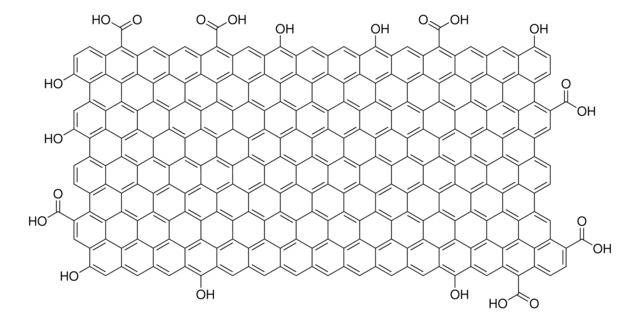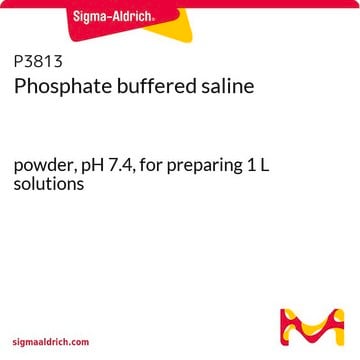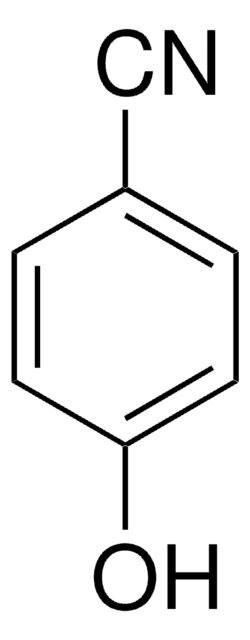345806
2,4,6-Trifluorophenol
99%
Se connecterpour consulter vos tarifs contractuels et ceux de votre entreprise/organisme
About This Item
Formule linéaire :
F3C6H2OH
Numéro CAS:
Poids moléculaire :
148.08
Numéro MDL:
Code UNSPSC :
12352100
ID de substance PubChem :
Nomenclature NACRES :
NA.22
Produits recommandés
Essai
99%
Forme
solid
Pf
49-51 °C (lit.)
Chaîne SMILES
Oc1c(F)cc(F)cc1F
InChI
1S/C6H3F3O/c7-3-1-4(8)6(10)5(9)2-3/h1-2,10H
Clé InChI
QQFWMPUXPLBWTG-UHFFFAOYSA-N
Description générale
2,4,6-Trifluorophenol is a halogen-substituted phenol. Peroxidase oxidation of 2,4,6-trifluorophenol has been reported. Association of phenol and 2,4,6-trifluorophenol has been investigated by 1H- and 19F-NMR spectroscopy.
Application
2,4,6-Trifluorophenol may be used in an indirect enzyme-linked immunosorbent assay (ELISA) for the biological monitoring of 2,4,6-trichlorophenol.
Mention d'avertissement
Warning
Mentions de danger
Classification des risques
Acute Tox. 4 Oral - Eye Irrit. 2 - Skin Irrit. 2 - STOT SE 3
Organes cibles
Respiratory system
Code de la classe de stockage
11 - Combustible Solids
Classe de danger pour l'eau (WGK)
WGK 3
Point d'éclair (°F)
Not applicable
Point d'éclair (°C)
Not applicable
Équipement de protection individuelle
dust mask type N95 (US), Eyeshields, Gloves
Faites votre choix parmi les versions les plus récentes :
Déjà en possession de ce produit ?
Retrouvez la documentation relative aux produits que vous avez récemment achetés dans la Bibliothèque de documents.
Les clients ont également consulté
Revisiting the peroxidase oxidation of 2,4,6-trihalophenols: ESR detection of radical intermediates.
Bradley E Sturgeon et al.
Chemical research in toxicology, 24(11), 1862-1868 (2011-09-29)
The peroxidase oxidation of 2,4,6-trichlorophenol (TCP) has been clearly shown to result in 2,6-dichloro-1,4-benzoquinone (DCQ). DCQ is a 2-electron oxidation product of TCP that has undergone para dechlorination. Many peroxidases show similar oxidation of the substrate, TCP, to yield the
Daniela Smejkalová et al.
Environmental science & technology, 43(14), 5377-5382 (2009-08-28)
1H- and 19F-NMR measurements of spin-lattice (T1) and spin-spin (T2) relaxationtimes and diffusion ordered spectroscopy (DOSY) were applied to investigate the association of nonsubstituted (phenol (P)) and halogen-substituted (2,4-dichlorophenol (DCP); 2,4,6-trichlorophenol (TCP), and 2,4,6-trifluorophenol (TFP) phenols with a dissolved humic
Roger Galve et al.
Analytical chemistry, 74(2), 468-478 (2002-01-29)
Trichlorophenols (TCP) eliminated by the urine can be considered as potential biomarkers of exposure of many chemicals (chlorophenols, chlorophenoxy acid herbicides, prochloraz, lindane, hexachlorobenzene, etc). High-throughput screening methods are necessary to carry out efficient monitoring programs that may help to
Erin M Kollitz et al.
Toxicological sciences : an official journal of the Society of Toxicology, 163(1), 226-239 (2018-02-07)
Brominated phenolic compounds (BPCs) are found in the environment, and in human and wildlife tissues, and some are considered to have endocrine disrupting activities. The goal of this study was to determine how structural differences of 3 BPC classes impact
Marie A Colucci et al.
Journal of medicinal chemistry, 50(23), 5780-5789 (2007-10-20)
NAD(P)H:quinone oxidoreductase 1 is a proposed target in pancreatic cancer. We describe the synthesis of a series of indolequinones, based on the 5- and 6-methoxy-1,2-dimethylindole-4,7-dione chromophores with a range of phenolic leaving groups at the (indol-3-yl)methyl position. The ability of
Notre équipe de scientifiques dispose d'une expérience dans tous les secteurs de la recherche, notamment en sciences de la vie, science des matériaux, synthèse chimique, chromatographie, analyse et dans de nombreux autres domaines..
Contacter notre Service technique












